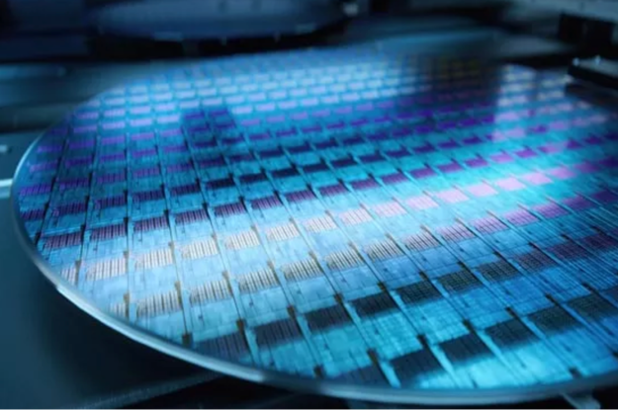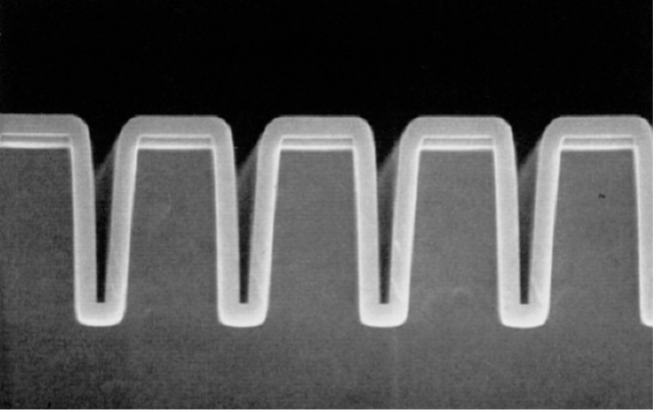Spatial Atomic Layer Deposition


Image: Thin film semiconductor wafer (L); Cross-sectional scanning electron microscope image of an Al2O3 ALD film with a thickness of 300 nm on a silicon wafer with a trench structure (R)
Thin films and specialised coatings have been the enabling technology for many ground-breaking innovations in modern life, including OLED screens, solar cells and battery technology. To make these products more efficient, expand their lifetime, or miniaturise them further, it is important that the thin film that is incorporated in the product, or is covering the product, is of a consistent and high quality. The deposition of thin films also has to happen at a sufficiently high rate to enable economically viable production at a cost price which can facilitate wide-scale adoption. Current technology has to trade-off high production throughput with high quality and conformity of the film.
Solving this has the ability to unlock transformational applications in several next generation innovations such as:
- Energy storage: Next generation solid state lithium batteries (with potentially 3x the lifespan, 3x the energy density and 1/6 the charge time of current cells)
- Flexible electronics: Thin film coatings can coat flexible substrates such as flexible OLED displays, wearable electronics and bendable sensors that can be used in various applications such as foldable phones, wearables and car windscreens.
- Solar power: Coatings for next generation solar cells such as perovskite solar cells that offer a step change in efficiency, cost and applications (a perovskite tandem cell offers a theoretical efficiency limit of 43% vs 29% for silicon cells)
- Barrier coating in packaging: Barrier coatings such as ultra-thin moisture barrier coating in recyclable food and beverage packaging, eliminating plastics and widening the application of carton packaging.
- Biomedical applications: Thin film biocompatible coatings on medical implants, devices, and diagnostic tools can enhance biocompatibility, reduce friction, and prevent bacterial adhesion, resulting in improved patient outcomes and device longevity.
- Optical coatings: Thin film coatings can be used in anti-reflective coatings, optical filters, and mirrors for applications in optics, photonics, and solar panels.
- Semiconductors: Thin, uniform coatings on packaging materials used in the semiconductor industry. These coatings can improve moisture resistance, thermal stability, and adhesion, enhancing the reliability and performance of semiconductor devices.
Spatial ALD (SALD) as a concept has however been stuck in laboratories and research departments as parties have not yet been able to solve how to build a machine that can process high volumes of film on a constant basis. There has been some early piloted commercial progress in Spatial ALD, but such machines are currently not able to produce at a high enough speed to be commercially feasible and suffer from cross-contamination requiring frequent stoppages. The throughput speed of Spatial ALD machines has a significant cost impact per square meter as the cost of the machines are high and a significant component in production cost. As such, there has not been a mass adoption of Spatial ALD to date.
Solving Spatial ALD in a continuous process is a key technology with tremendous commercial impact in unlocking transformational innovation in a range of industries across electronics, energy storage, packaging and healthcare.
The Netherlands is a critical global hub for research and development in this space, with technology development hubs in Eindhoven and Delft supported by the universities and state-backed research institutes and regional development funds, and skills highly related to the success that ASML has fostered in the region.
At the end of 2023 we signed a term sheet to lead a strong consortium of investors into a promising early-stage startup that has developed machinery and IP that has the potential to solve Spatial ALD in a continuous process. This has the potential to lower the cost of thin films to around 1/20th of current technology, while dramatically improving their functional performance and consequently hugely expanding their application. We are exceptionally excited about the future potential of this transformative technology.
FAIRTREE INSIGHTS
Your may also be interested in
Explore more commentaries from our thought leaders, offering in-depth analysis, market trends and expert analysis.

Macro Pulse Episode 21
In this episode Jacobus discusses SA equities, SA bonds and the appreciating of the US dollar.

Fairtree Market Insights with Karena Naidu | Episode 8
In this episode, we dive into our Chinese exposure, exploring what’s happening with the major e-commerce players in China. We also take a closer look at the broader emerging markets space, unpacking key trends and where we’re seeing potential growth.

Macro Pulse Episode 20
In this episode, Jacobus discusses major events leading up to year-end, recent US court cases, and the rise in long bond yields.

Fairtree Market Insights with Karena Naidu | Episode 7: Part 2
Market Insights, an exciting video series where Karena Naidu, Global Investment Specialist, delves into key insights in global equity markets with Equity Portfolio Managers Cornelius Zeeman and Jacques Haasbroek.
We are Fairtree
Subscribe to our newsletter
Stay informed with the latest insights and updates. Subscribe to our newsletter for expert analysis, market trends, and investment strategies delivered straight to your inbox.
"*" indicates required fields

About you…
By proceeding, I confirm that:
- To the best of my knowledge, and after making all necessary inquiries, I am permitted under the laws of my country of residence to access this site and the information it contains; and
- I have read, understood, and agree to be bound by the Terms and Conditions of Use described below.
- Please beware of fraudulent Whatsapp groups pretending to be affiliated with Fairtree or Fairtree staff members.
If you do not meet these requirements, or are unsure whether you do, please click “Decline” and do not continue.


